МакЛарън MP4-29 (представяне)
Тук ще проследим представянето на МакЛарън MP4/29, с който отбора ще се състезава във Формула 1 през 2014 година.
МакЛарън показаха първите истински снимки на болид за 2014 година. Малко преди 14:00 днес на сайта на МакЛарън се появиха снимките и ... първата ми реакция беше "ох ...". Първата снимка, която видях беше на носа и ... трябва да сме честни - гледката не е от най-красивите. Но, с тези правила ще е е така.
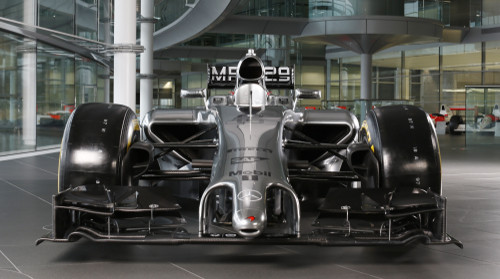
МакЛарън са избрали подобен на Уилямс подход със стърчащо ... всъщност нямам идея как трябва да го наричаме на български това "нещо". Както и да е. Нека да се абстрахираме от това "нещо". Носа на болида ми напомня на миналогодишния Мерцедес. Пилоните са интегрирани и също като при Уилямс са прибрани назад създавайки впечатление, че носа се стеснява, като същевременно са доста отдалечени един от друг.
Гледайки болида отпред веднага правят впечатление няколко неща. Отворите за кутиите на радиаторите са доста големи, както и при Уилямс. Това разбира се се дължи на повишените изисквания за охлаждането на новите V6 турбо двигатели. Въпреки това изрязването под тях е доста голямо и това ще позволи на повече въздух да достига до дифузьора.
Второто нещо, което прави впечатление е връщането на МакЛарън към предното пуш-род окачване. При толкова много неизвестни този сезон, а и разбира се връщането към относително по-ниски ниски носове, това изглежда логично решение.
Помните ли качулката зад основния въздухозаборник на болида на Форс Индия? Е, МакЛарън нямат такъв, но ако се вгледате в основния въздухозаборник ще видите как той е разделен на две.
Предното крило много прилича на миналогодишното, но вертикалните плоскости в краищата му са различни. Вероятно обаче крилото ще се промени доста до началото на сезона.
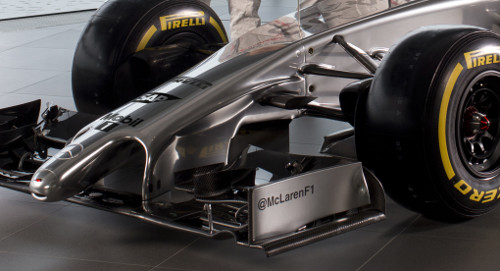
Обърнете внимание как МакЛарън са съчетали пилоните и плоскостите под носа на горната снимка. Също така точно пред камерите има известен релеф. Всичко това е с цел да се подобри преминаването на въздуха около елементите на окачването, както и да минимизира до известна степен вихрите, които се получават от гумите. Това пък би довело до намаляване на челното съпротивление.
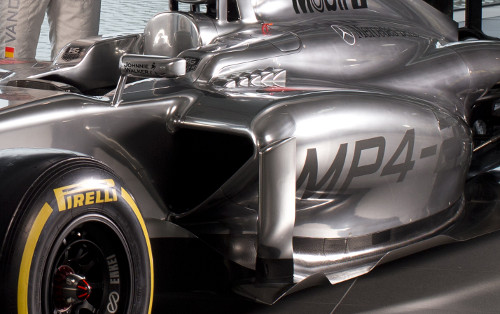
Около кокпита обаче има нещо недовършено. вертикалните плоскости свършват нелогично ниско. Ако сте обърнали внимание на видеото с 3D анимацията малко по-долу ще видите, че липсва гребенчето с малки вертикални плоскости, които се намират точно над отворите на кутиите за радиаторите. Изгледайте и второто видео - това със Сам Майкъл и ще видите доста интересни графики, които също показват наличието на въпросното гребенче. По-интересното обаче е наличието на елемент, който наподобява буквата U в края на кутията за радиатора. Подобни елементи имаше на Забер, а както знаем Мат Морис вече е част от МакЛарън така, че трансфера на идеи явно се случва.
Всичко това ме навежда на мисълта, че показаното от МакЛарън като болид днес не е точно това, което ще видим малко по-късно тази година.
Разбира се до главата на пилота присъстват хрилете за охлаждане - нещо, което видяхме, както от Форс Индия, така и от Уилямс. Всички те с двигатели на Мерцедес.
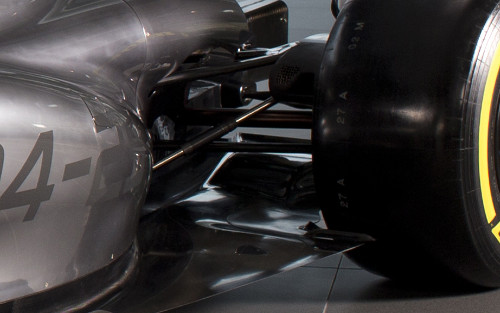
Поне за мен най-интересно ще бъде да видим промените по задниците на колите, защото именно там отборите ще загубят най-много притискане. Премахването на обдухването, както и малкото крило над краш структурата (beam wing) ще доведат до доста работа в тази насока.
МакЛарън са се постарали да изчистят доста задницата на болида си. Макар и да изглежда доста "мускулест" зад кокпита, гледан отгоре болида всъщност има доста прилична форма, която специалистите наричат Coke Bottle, защото наподобява оригиналната бутилка на Coca-Cola. Разбира се това се дължи на акта, че вече ауспуха е само един. Обърнете внимание на празното пространство на пода пред и около задната гума на горната снимка. Точно пред задната гума присъстват и познатите ни нарези и качулки на пода.
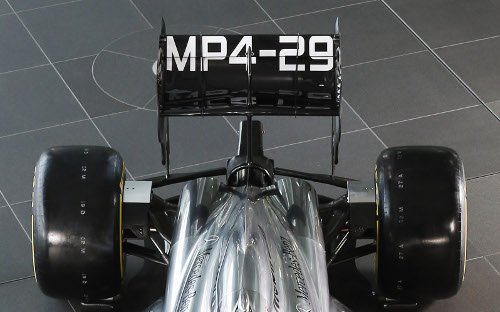
За първи път тази година имаме възможност да погледнем към задницата на реален болид. И гледката определено е интересна. Задното крило вероятно е старо, но по-интересното е, че има централна опора. А още по-интересното е, че тази опора представлява обърната буква Y, която обхваща ауспуха.
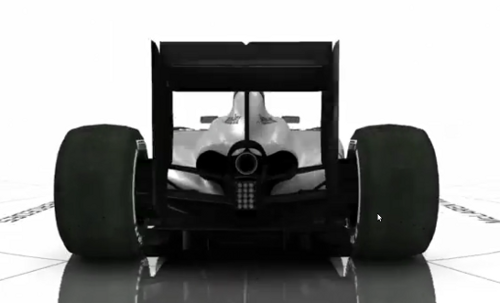
Макар и генерирано изображение ясно се вижда, че МакЛарън ще се опитат да използват окачването като "beam wing", за да върнат поне малко от загубеното притискане. На графиките пък от видеото със Сам Майкъл можете да видите и малкото крилце "monkey seat", което отбора смята да използва.
Обърнете внимание и на оформянето на каросерията. МакЛарън са решили да изкарат всичкия горещ въздух през оформените два отвора в задната част, които се намират от двете страни на ауспуха.
Кутиите за охлаждане на задните спирачки или липсваха на показания ни болид или бяха покрити.
Като цяло доста интересни решения има по новия МакЛарън, а вероятно и предстоят още доста да видим, защото колата не изглежда съвсем завършена. Да не забравяме, че почти винаги на представянията моделите не отговарят на реалните болиди. Разочароващо е обаче да видим липсата на главен спонсор и като цяло малкото реклами върху колата. Това придава постен изглед на болида. Ако и дизайнерите успеят да маскират малко носа ... например така или така, то всички фенове ще бъде малко по-щастливи.
Утре ни предстои да видим и новото Ферари. Дали отново ще имаме грозен нос? Без съмнение, но въпроса е по-скоро колко ще е грозен :)






Дженсън Бътън:
Кевин Магнусен:
Стофел Вандорн:
Сам Майкъл:
Джонатан Нийл:
Chassis
Monocoque: Carbon-fibre composite incorporating driver cockpit controls and fuel cell
Safety structures: Cockpit survival cell incorporating impact resistant construction and penetration panels, front impact structure, prescribed side impact structures, integrated rear impact structure, front and rear roll structures
Bodywork: Carbon-fibre composite. including engine cover, sidepods, floor, nose, front wing and rear wing, Driver-operated drag reduction system
Front suspension: Carbon-fibre wishbone and pushrod suspension elements operating inboard torsion bar and damper system
Rear suspension: Carbon-fibre wishbone and pullrod suspension elements operating inboard torsion bar and damper system
Weight: Overall vehicle weight no more than 690kg without fuel, Weight distribution between 45.5% and 46.5%, (Subject to tyre weight adjustments and axle weight limits)
Electronics: McLaren Applied Technologies. Including chassis control, engine control, data acquisition, alternator, sensors, data analysis and telemetry
Instruments: McLaren Applied Technologies dashboard
Lubricants & fluids: Mobilith SHC 1500 Grease – high-temperature drive-shaft tripod lubrication, Mobilith SHC 220 Grease – low rolling-resistance ceramic wheel bearing lubrication, Mobil SHC Hydraulic Oil – high-pressure, high-temperature hydraulic fluid used for driver, transmission and power-unit control actuators
Brake system: Akebono calipers and master cylinders, Akebono 'brake by wire' rear brake control system, Carbon discs and pads
Steering: McLaren Racing power-assisted
Tyres: Pirelli P Zero
Race wheels: Enkei
Radio: Kenwood
Paint: AkzoNobel Car Refinishes system using Sikkens products
Power Unit
Type: Mercedes-Benz PU106A Hybrid
Minimum weight: 145 kg
Primary PU components: Internal Combustion Engine (ICE)
Motor Generator Unit – Kinetic (MGU-K)
Motor Generator Unit – Heat (MGU-H)
Energy store (ES)
Turbocharger
Control electronics
Internal Combustion Engine
Capacity: 1.6 litres
Cylinders: Six
Bank angle: 90 degree vee angle
No of valves: 24
Max speed: 15,000 rpm
Max fuel flow rate: 100kg/hour (above 10,500 rpm)
Fuel consumption: 100kg ‘lights to flag’ regulated fuel capacity limit
Fuel injection: 500bar direct injection, single injector per cylinder
Pressure charging: Single-stage compressor and exhaust turbine, common shaft
Lubricant: Mobil 1 Engine Oil – high-protection low-friction lubricant and coolant, for high durability and improved fuel economy
Fuel: ExxonMobil High Performance Unleaded (5.75% bio fuel)
Energy Recovery System
Architecture
Integrated Hybrid energy recovery via Motor Generator Units
Crankshaft coupled electrical MGU-K
Turbocharger coupled electrical MGU-H
Energy store
Lithium-Ion battery, between 20 and 25 kg
Maximum energy storage, 4 MJ per lap
MGU-K
Maximum speed, 50,000 rpm
Maximum power, 120 kW
Maximum energy recovery, 2 MJ per lap
Maximum energy deployment, 4 MJ per lap
MGU-H
Maximum speed 125,000 rpm
Maximum power, unlimited
Maximum energy recovery, unlimited
Maximum energy deployment, unlimited
Transmission
Gearbox: Carbon-fibre composite case
Gears: Eight forward and one reverse
Gear selection: McLaren Racing hand-operated seamless-shift
Differential: Epicyclic differential with multi-plate limited-slip clutch
Clutch: Carbon/carbon, hand-operated
Lubricant: Mobil 1 SHC Gear Oil – Low traction-loss, high-efficiency gear and bearing lubricant and coolant
Още от сезон 2014:
Само регистрирани потребители могат да коментират. Ако вече имате регистрация можете да влезете в сайта от "Вход". В противен случай можете да се регистирате като натиснете "Вход" и избере "Регистрация". За повече информация: f1.f-e-n.net/index.php/url14729
МакЛарън показаха първите истински снимки на болид за 2014 година. Малко преди 14:00 днес на сайта на МакЛарън се появиха снимките и ... първата ми реакция беше "ох ...". Първата снимка, която видях беше на носа и ... трябва да сме честни - гледката не е от най-красивите. Но, с тези правила ще е е така.

МакЛарън са избрали подобен на Уилямс подход със стърчащо ... всъщност нямам идея как трябва да го наричаме на български това "нещо". Както и да е. Нека да се абстрахираме от това "нещо". Носа на болида ми напомня на миналогодишния Мерцедес. Пилоните са интегрирани и също като при Уилямс са прибрани назад създавайки впечатление, че носа се стеснява, като същевременно са доста отдалечени един от друг.
Гледайки болида отпред веднага правят впечатление няколко неща. Отворите за кутиите на радиаторите са доста големи, както и при Уилямс. Това разбира се се дължи на повишените изисквания за охлаждането на новите V6 турбо двигатели. Въпреки това изрязването под тях е доста голямо и това ще позволи на повече въздух да достига до дифузьора.
Второто нещо, което прави впечатление е връщането на МакЛарън към предното пуш-род окачване. При толкова много неизвестни този сезон, а и разбира се връщането към относително по-ниски ниски носове, това изглежда логично решение.
Помните ли качулката зад основния въздухозаборник на болида на Форс Индия? Е, МакЛарън нямат такъв, но ако се вгледате в основния въздухозаборник ще видите как той е разделен на две.
Предното крило много прилича на миналогодишното, но вертикалните плоскости в краищата му са различни. Вероятно обаче крилото ще се промени доста до началото на сезона.

Обърнете внимание как МакЛарън са съчетали пилоните и плоскостите под носа на горната снимка. Също така точно пред камерите има известен релеф. Всичко това е с цел да се подобри преминаването на въздуха около елементите на окачването, както и да минимизира до известна степен вихрите, които се получават от гумите. Това пък би довело до намаляване на челното съпротивление.

Около кокпита обаче има нещо недовършено. вертикалните плоскости свършват нелогично ниско. Ако сте обърнали внимание на видеото с 3D анимацията малко по-долу ще видите, че липсва гребенчето с малки вертикални плоскости, които се намират точно над отворите на кутиите за радиаторите. Изгледайте и второто видео - това със Сам Майкъл и ще видите доста интересни графики, които също показват наличието на въпросното гребенче. По-интересното обаче е наличието на елемент, който наподобява буквата U в края на кутията за радиатора. Подобни елементи имаше на Забер, а както знаем Мат Морис вече е част от МакЛарън така, че трансфера на идеи явно се случва.
Всичко това ме навежда на мисълта, че показаното от МакЛарън като болид днес не е точно това, което ще видим малко по-късно тази година.
Разбира се до главата на пилота присъстват хрилете за охлаждане - нещо, което видяхме, както от Форс Индия, така и от Уилямс. Всички те с двигатели на Мерцедес.

Поне за мен най-интересно ще бъде да видим промените по задниците на колите, защото именно там отборите ще загубят най-много притискане. Премахването на обдухването, както и малкото крило над краш структурата (beam wing) ще доведат до доста работа в тази насока.
МакЛарън са се постарали да изчистят доста задницата на болида си. Макар и да изглежда доста "мускулест" зад кокпита, гледан отгоре болида всъщност има доста прилична форма, която специалистите наричат Coke Bottle, защото наподобява оригиналната бутилка на Coca-Cola. Разбира се това се дължи на акта, че вече ауспуха е само един. Обърнете внимание на празното пространство на пода пред и около задната гума на горната снимка. Точно пред задната гума присъстват и познатите ни нарези и качулки на пода.

За първи път тази година имаме възможност да погледнем към задницата на реален болид. И гледката определено е интересна. Задното крило вероятно е старо, но по-интересното е, че има централна опора. А още по-интересното е, че тази опора представлява обърната буква Y, която обхваща ауспуха.

Макар и генерирано изображение ясно се вижда, че МакЛарън ще се опитат да използват окачването като "beam wing", за да върнат поне малко от загубеното притискане. На графиките пък от видеото със Сам Майкъл можете да видите и малкото крилце "monkey seat", което отбора смята да използва.
Обърнете внимание и на оформянето на каросерията. МакЛарън са решили да изкарат всичкия горещ въздух през оформените два отвора в задната част, които се намират от двете страни на ауспуха.
Кутиите за охлаждане на задните спирачки или липсваха на показания ни болид или бяха покрити.
Като цяло доста интересни решения има по новия МакЛарън, а вероятно и предстоят още доста да видим, защото колата не изглежда съвсем завършена. Да не забравяме, че почти винаги на представянията моделите не отговарят на реалните болиди. Разочароващо е обаче да видим липсата на главен спонсор и като цяло малкото реклами върху колата. Това придава постен изглед на болида. Ако и дизайнерите успеят да маскират малко носа ... например така или така, то всички фенове ще бъде малко по-щастливи.
Утре ни предстои да видим и новото Ферари. Дали отново ще имаме грозен нос? Без съмнение, но въпроса е по-скоро колко ще е грозен :)
McLaren MP4-29 - 360 View

Technical Lowdown: McLaren Mercedes MP4-29

Jenson Button: How I'll Tackle 2014

Kevin Magnussen: It'll Be Old Skool Sideways Driving

Jonathan Neale: The Big Picture

Sam Michael: 2014 In Brief

Дженсън Бътън:
What are your realistic aims for the 2014 season?
Obviously, we want to get back to the front. We want to have a better season than we did in 2013, too. But it’s really difficult to accurately predict anything right now – these are such huge changes that they’ll have a massive impact on the competitive order, so we need to wait and just see how things shake out. Our aim must be to have a smooth and productive winter; I’m very keen to learn all about the new formula and our new car, and I want us to be in a position where we head to the opening flyaways feeling comfortable with our package, yet still ready to absorb and learn more as we go. I don’t think anybody’s anticipating the next few months to be easy – I can’t imagine anybody in the pitlane would admit to that – but our aim must be to make progress all the time, and to learn positively as we go.
Is it difficult to get to grips with so many changes all at once?
It’s part of the job of a Formula 1 driver. I’ve spent my whole career jumping from different specification cars – I’ve driven V10s, V8s, I’ve raced on grooved tyres, on slicks, with KERS, with DRS, with traction control, without it, with refueling, without it. I’m still here! Obviously, there’s a period of adaption, but the way I drive – working upwards to find the grip level, rather than working downwards – has always made it quite a seamless transition. As a driver, it’s just an exciting time. I’m really looking forward to it – I love the mental challenge of tackling such a complex task; there’s so much to get your teeth into, and the prospect of problem-solving, and pulling apart difficult concepts and drilling down to find the best solution – that really motivates me.
Nevertheless, are you worried about the state of flux ahead of this new formula?
I think every single person in Formula 1 is sitting on the edge of the unknown. That’s both exciting and unsettling in equal measure. There will be lots of things going through my mind when I settle myself into the cockpit for the first time in Jerez next week, but, above all else, what I’ll be looking for is that simple, positive feeling you get from knowing that the car beneath you is a solid platform; one you can work with, and one you can develop throughout the season. I don’t think anybody will be coming out of this first test feeling certain that they’ve cracked this new formula. I think it’ll be more of a case of slowly peeling away successive layers as the engineers and designers gather more information and gain an understanding of how the cars and power-units are behaving; and we’ll see that being gradually refined throughout the forthcoming tests and into the opening races. I think this formula is too big, and too complex, for a single team to feel secure about getting everything right and quickly establishing an advantage. It’s about diligently chipping away at it that we’ll get there.
Finally, how does it feel having a new team-mate alongside you?
I haven’t really got to know Kevin properly as a team-mate yet. Over the winter, there aren’t too many opportunities for us to spend time together, but that will change once we go testing – we’ll be working very closely together to share data and gather as much information as we can about what the car’s doing, and how we can improve it. But, yeah, I’ve been very impressed by Kevin all along – he clearly did a very good job last year and drove superbly to win the World Series by Renault championship. And I’ve been pleased by his professionalism and determination this year – it’s a very difficult job for any driver in F1 this year, but I’
Im absolutely sure he’ll do a great job.
Obviously, we want to get back to the front. We want to have a better season than we did in 2013, too. But it’s really difficult to accurately predict anything right now – these are such huge changes that they’ll have a massive impact on the competitive order, so we need to wait and just see how things shake out. Our aim must be to have a smooth and productive winter; I’m very keen to learn all about the new formula and our new car, and I want us to be in a position where we head to the opening flyaways feeling comfortable with our package, yet still ready to absorb and learn more as we go. I don’t think anybody’s anticipating the next few months to be easy – I can’t imagine anybody in the pitlane would admit to that – but our aim must be to make progress all the time, and to learn positively as we go.
Is it difficult to get to grips with so many changes all at once?
It’s part of the job of a Formula 1 driver. I’ve spent my whole career jumping from different specification cars – I’ve driven V10s, V8s, I’ve raced on grooved tyres, on slicks, with KERS, with DRS, with traction control, without it, with refueling, without it. I’m still here! Obviously, there’s a period of adaption, but the way I drive – working upwards to find the grip level, rather than working downwards – has always made it quite a seamless transition. As a driver, it’s just an exciting time. I’m really looking forward to it – I love the mental challenge of tackling such a complex task; there’s so much to get your teeth into, and the prospect of problem-solving, and pulling apart difficult concepts and drilling down to find the best solution – that really motivates me.
Nevertheless, are you worried about the state of flux ahead of this new formula?
I think every single person in Formula 1 is sitting on the edge of the unknown. That’s both exciting and unsettling in equal measure. There will be lots of things going through my mind when I settle myself into the cockpit for the first time in Jerez next week, but, above all else, what I’ll be looking for is that simple, positive feeling you get from knowing that the car beneath you is a solid platform; one you can work with, and one you can develop throughout the season. I don’t think anybody will be coming out of this first test feeling certain that they’ve cracked this new formula. I think it’ll be more of a case of slowly peeling away successive layers as the engineers and designers gather more information and gain an understanding of how the cars and power-units are behaving; and we’ll see that being gradually refined throughout the forthcoming tests and into the opening races. I think this formula is too big, and too complex, for a single team to feel secure about getting everything right and quickly establishing an advantage. It’s about diligently chipping away at it that we’ll get there.
Finally, how does it feel having a new team-mate alongside you?
I haven’t really got to know Kevin properly as a team-mate yet. Over the winter, there aren’t too many opportunities for us to spend time together, but that will change once we go testing – we’ll be working very closely together to share data and gather as much information as we can about what the car’s doing, and how we can improve it. But, yeah, I’ve been very impressed by Kevin all along – he clearly did a very good job last year and drove superbly to win the World Series by Renault championship. And I’ve been pleased by his professionalism and determination this year – it’s a very difficult job for any driver in F1 this year, but I’
Im absolutely sure he’ll do a great job.
Кевин Магнусен:
How have your preparations been going over the winter?
I’ve just had a singular focus: it’s been about immersing myself within the organisation, with the people, and getting to grips with everything that I’ll face when I finally sit in the cockpit later this month. It’s no secret that I live in Woking and I go to the MTC every day. So I’ve spent every available day working – either with my engineers, with the team management, or with the trainers at MTC; building those relationships, getting to grips with the car, the style of driving, the cockpit and control systems, and improving my fitness. It’s a constant learning curve, but it’s fun and satisfying to be able to do it with a group of people who work so closely with you. It’s been relentless, but I’ve enjoyed the discipline and focus of the winter. It will actually be nice to arrive in Jerez, to hopefully look out at a blue sky, and drive the car!
Despite all the preparation, is there a sense of nervousness going into the first test?
Naturally, sure. You never reach a point where you feel completely ‘ready’ – there’s always more you can do. But I think every team and driver is going to be feeling uncertain going into the pre-season. Personally, I’m just working hard to make sure that I’m as ready as I realistically can be – so I’ve learned the cockpit systems inside-out, I’ve been in the gym at the MTC every day, and I’ve worked hard with my engineers to understand just what to expect from this new formula. In a way, the regulation changes makes things a little easier: at that first test in Jerez, everybody will be easing themselves into something new, rather than just getting in the car and driving away, so I’ll really be no different from any other driver. It’ll be how we react during the season that will define how successful we are. I know the engineers are working on new things all the time, but I think there’s still plenty of scope to move forward. I don’t think you’ll get a definitive read on who’s competitive and who’s not until at least the Bahrain tests – maybe even later.
What’s the biggest challenge to overcome ahead of the new season?
I guess it’s just getting to know people, feeling comfortable within this new environment, and learning what you can and can’t affect. One of the things that’s really struck me at McLaren is just how much influence you have as a driver – I can test something in the simulator, or we can work on something in the cockpit, and they’ll really listen to my input and, the next time you get in the sim, or the mock-up car, it’s been changed at your recommendation. That’s impressive, and it encourages me that this team has the speed and motivation to react quickly to any changes. I’m learning how the team works, too. Obviously, a World Series team is a much smaller operation – you know everybody – and this is much, much bigger, so getting used to that has taken a bit of time. Obviously, I haven’t really experienced much in terms of media and marketing yet – I’ve been in something of a cocoon – but I’m looking forward to getting out on the road with the team, going testing and seeing what happens.
I’ve just had a singular focus: it’s been about immersing myself within the organisation, with the people, and getting to grips with everything that I’ll face when I finally sit in the cockpit later this month. It’s no secret that I live in Woking and I go to the MTC every day. So I’ve spent every available day working – either with my engineers, with the team management, or with the trainers at MTC; building those relationships, getting to grips with the car, the style of driving, the cockpit and control systems, and improving my fitness. It’s a constant learning curve, but it’s fun and satisfying to be able to do it with a group of people who work so closely with you. It’s been relentless, but I’ve enjoyed the discipline and focus of the winter. It will actually be nice to arrive in Jerez, to hopefully look out at a blue sky, and drive the car!
Despite all the preparation, is there a sense of nervousness going into the first test?
Naturally, sure. You never reach a point where you feel completely ‘ready’ – there’s always more you can do. But I think every team and driver is going to be feeling uncertain going into the pre-season. Personally, I’m just working hard to make sure that I’m as ready as I realistically can be – so I’ve learned the cockpit systems inside-out, I’ve been in the gym at the MTC every day, and I’ve worked hard with my engineers to understand just what to expect from this new formula. In a way, the regulation changes makes things a little easier: at that first test in Jerez, everybody will be easing themselves into something new, rather than just getting in the car and driving away, so I’ll really be no different from any other driver. It’ll be how we react during the season that will define how successful we are. I know the engineers are working on new things all the time, but I think there’s still plenty of scope to move forward. I don’t think you’ll get a definitive read on who’s competitive and who’s not until at least the Bahrain tests – maybe even later.
What’s the biggest challenge to overcome ahead of the new season?
I guess it’s just getting to know people, feeling comfortable within this new environment, and learning what you can and can’t affect. One of the things that’s really struck me at McLaren is just how much influence you have as a driver – I can test something in the simulator, or we can work on something in the cockpit, and they’ll really listen to my input and, the next time you get in the sim, or the mock-up car, it’s been changed at your recommendation. That’s impressive, and it encourages me that this team has the speed and motivation to react quickly to any changes. I’m learning how the team works, too. Obviously, a World Series team is a much smaller operation – you know everybody – and this is much, much bigger, so getting used to that has taken a bit of time. Obviously, I haven’t really experienced much in terms of media and marketing yet – I’ve been in something of a cocoon – but I’m looking forward to getting out on the road with the team, going testing and seeing what happens.
Стофел Вандорн:
What will your role be as McLaren’s reserve driver?
Obviously, I’m really pleased and excited to have been chosen as the team’s reserve driver. I’ll be working with the other drivers to develop the car using the simulator, which is something I’ve been doing since I became a McLaren Young Driver. And, as I’ll be contesting the GP2 championship this year, with ART GP2, I’ll also be present at many grands prix, and I’ll be integrated into the race team’s programme, assisting Jenson and Kevin wherever I can.
What are your aims for the 2014 season?
Naturally, my aim this year is to win the GP2 championship, but the natural extension of that is the ambition to graduate to Formula 1 – so I want to be in a position where I can contribute to, and learn from, the race team as possible throughout the season. I’m positive that I can keep the momentum that I’ve developed over the past few years moving forwards.
How have you started to integrate yourself with the team?
Well, I’ve been a McLaren Young Driver for almost a year, and I’ve been making increasingly regular visits to the MTC. I’m usually there at least once a week nowadays, and I’m increasing my workload and fitness levels so I can more fully commit. It’s an exciting time for me.
Obviously, I’m really pleased and excited to have been chosen as the team’s reserve driver. I’ll be working with the other drivers to develop the car using the simulator, which is something I’ve been doing since I became a McLaren Young Driver. And, as I’ll be contesting the GP2 championship this year, with ART GP2, I’ll also be present at many grands prix, and I’ll be integrated into the race team’s programme, assisting Jenson and Kevin wherever I can.
What are your aims for the 2014 season?
Naturally, my aim this year is to win the GP2 championship, but the natural extension of that is the ambition to graduate to Formula 1 – so I want to be in a position where I can contribute to, and learn from, the race team as possible throughout the season. I’m positive that I can keep the momentum that I’ve developed over the past few years moving forwards.
How have you started to integrate yourself with the team?
Well, I’ve been a McLaren Young Driver for almost a year, and I’ve been making increasingly regular visits to the MTC. I’m usually there at least once a week nowadays, and I’m increasing my workload and fitness levels so I can more fully commit. It’s an exciting time for me.
Сам Майкъл:
What are McLaren’s expectations for 2014?
We’ve made no secret of our disappointment at how the 2013 season turned out. The aim now is to get back to winning – that’s what McLaren exists to do – but there’s a certain amount of growth and regrowth that needs to take place before we return to a position where we can challenge for the world championship. The good thing is that we’ve acknowledged that, and we’ve actually been working towards that goal for many months now. We have Honda waiting in the wings, we have a number of key technical staff bolstering our existing design and engineering teams, and we are fostering the careers of our young drivers, all of whom have an incredible amount of potential. The future for McLaren is bright, and we’re now putting in place the processes that will move us closer to our goals. For 2014, our aim is for continuous development; we’ll be refining and strengthening the car and the organisation throughout the year, so you’ll see a rapid turnover of parts and ideas on the car as we, like every team, wrestle with the many unique challenges of these new regulations. More immediately, our aim is to enjoy a smooth winter at all three tests, hopefully learning a lot as we go, and hopefully developing MP4-29 into something consistent, useable and quick.
How do you balance the equation of reliability vs performance?
I think the key to the first quarter of the season could well be consistency. It’ll be critical in the pre-season tests – firstly, to enable the drivers and engineers to learn about and understand the behavior of the new car; but, secondly, to provide us with the mileage and data our designers at the MTC need to further refine and develop the car for the year ahead. It’ll be a season of complexity and subtlety; we won’t find ourselves in a situation where the guy who wins the first race goes on to win the championship, I think it’ll be unpredictable and exciting – and that’s fantastic news for Formula 1’s fans. One thing is for certain, though, there’ll be a lot of cross-pollination of ideas during the season as the best concepts and solutions proliferate. We’re proud of some of the concepts we’ll be introducing with this car but, likewise, there’ll be areas where we can learn and improve. In fact, I think constant learning and improvement will be the key motifs of 2014.
We’ve made no secret of our disappointment at how the 2013 season turned out. The aim now is to get back to winning – that’s what McLaren exists to do – but there’s a certain amount of growth and regrowth that needs to take place before we return to a position where we can challenge for the world championship. The good thing is that we’ve acknowledged that, and we’ve actually been working towards that goal for many months now. We have Honda waiting in the wings, we have a number of key technical staff bolstering our existing design and engineering teams, and we are fostering the careers of our young drivers, all of whom have an incredible amount of potential. The future for McLaren is bright, and we’re now putting in place the processes that will move us closer to our goals. For 2014, our aim is for continuous development; we’ll be refining and strengthening the car and the organisation throughout the year, so you’ll see a rapid turnover of parts and ideas on the car as we, like every team, wrestle with the many unique challenges of these new regulations. More immediately, our aim is to enjoy a smooth winter at all three tests, hopefully learning a lot as we go, and hopefully developing MP4-29 into something consistent, useable and quick.
How do you balance the equation of reliability vs performance?
I think the key to the first quarter of the season could well be consistency. It’ll be critical in the pre-season tests – firstly, to enable the drivers and engineers to learn about and understand the behavior of the new car; but, secondly, to provide us with the mileage and data our designers at the MTC need to further refine and develop the car for the year ahead. It’ll be a season of complexity and subtlety; we won’t find ourselves in a situation where the guy who wins the first race goes on to win the championship, I think it’ll be unpredictable and exciting – and that’s fantastic news for Formula 1’s fans. One thing is for certain, though, there’ll be a lot of cross-pollination of ideas during the season as the best concepts and solutions proliferate. We’re proud of some of the concepts we’ll be introducing with this car but, likewise, there’ll be areas where we can learn and improve. In fact, I think constant learning and improvement will be the key motifs of 2014.
Джонатан Нийл:
Formula 1 in 2014 is all about managing change – how is McLaren going about that?
We’ve never had such significant new regulations before; reacting to them, and managing those changes, while still pushing the performance limits, has been an extremely tough job. We’ve been relatively pragmatic about it. We know that the need for consistency initially outweighs the need for performance – the winter tests won’t be about chasing set-up or refining the car; the envelope of performance is likely to be so wide, and so relatively unknown, that the winter – and to some extent the opening races – will be about understanding the operational boundaries of the car as best we can. To achieve this, we need a consistent platform – one that responds positively to changes. Moreover, the work of the engineers and designers to understand and interpret trackside data will be more important than before. That’s because this year, more than ever, will come down to a development race: I don’t necessarily think you can expect the car that wins the opening race to be the car that leads the championship charge, something we’ve often seen in the past. No, it will be all about a team’s ability to react and respond. We already have an update package that we’re readying for race one, and we’re discovering new things in the ’tunnel, or in CFD, all the time. Once we start track testing, I think you’ll see an intense throughput of ideas and concepts – that’s the nitty-gritty that will win or lose the world championship.
There’s a greater backdrop of change at McLaren, too, isn’t there?
A team with a fantastic heritage like McLaren is always faced with the challenge of continually winning races and championships. Equally, there’s a responsibility to move the organisation – and our processes – forwards. In fact, we’ll be doing just that during 2014: pushing ahead with an incredible amount of effort, analysis and commitment on the racetrack, but also making changes away from the track that will reap a greater dividend in the long term. There’s a huge amount of talent and potential already extant within the organisation, but there’s always more to discover. And we’ve made some very important key additions who’ll have a significant input into our future momentum – we’re incredibly pleased and excited to have hired the likes of Peter Prodromou and Dan Fallows, both from Red Bull Racing, and Ettore Griffini and Ciaron Pilbeam from Lotus, as well as more than a dozen top-level engineers from among the best teams in Formula 1, all of whom have seen the capacity and potential that exists here at McLaren. Nonetheless, this is a long-term process, and this year will be about developing and growing McLaren to a position where we can once again fight at the front.
What are your thoughts on the driver pairing of Jenson and Kevin?
We all know and like Jenson very much – he’s an integral part of this team now. And Kevin has shown such fantastic promise – both in the junior series, and on the occasions that he has tested for us – that it made absolute sense to develop him as our race driver. I really think the beauty of our driver line-up comes from its strength and structure through sheer contrast. In Jenson, we have Formula 1’s unofficial ambassador, somebody who provides us with an unprecedented databank of experience; we can really work with him as we learn together how to develop and refine this year’s car. In Kevin, I see a raw, unfettered enthusiasm and a fearsome work ethic. His arrival has been a terrific motivator for the entire team, and I’ve been really pleased and impressed by the way he’s thrown himself into the process. While he’ll naturally need time to acclimatise, we’re undoubtedly of the opinion that he’s ready for F1. Additionally, we have Stoffel Vandoorne as our reserve – another driver whose long-term potential is tantalising. He’ll have an increasingly complementary role alongside our two drivers – he’ll be attending all the races where GP2 is on the support bill, and will be heavily dialed in to our trackside operations as we ramp up his learning and experience. I think we have a fantastic line-up, and the best thing is that each driver will motivate and inform the other – it’s a win-win situation for the whole team.
We’ve never had such significant new regulations before; reacting to them, and managing those changes, while still pushing the performance limits, has been an extremely tough job. We’ve been relatively pragmatic about it. We know that the need for consistency initially outweighs the need for performance – the winter tests won’t be about chasing set-up or refining the car; the envelope of performance is likely to be so wide, and so relatively unknown, that the winter – and to some extent the opening races – will be about understanding the operational boundaries of the car as best we can. To achieve this, we need a consistent platform – one that responds positively to changes. Moreover, the work of the engineers and designers to understand and interpret trackside data will be more important than before. That’s because this year, more than ever, will come down to a development race: I don’t necessarily think you can expect the car that wins the opening race to be the car that leads the championship charge, something we’ve often seen in the past. No, it will be all about a team’s ability to react and respond. We already have an update package that we’re readying for race one, and we’re discovering new things in the ’tunnel, or in CFD, all the time. Once we start track testing, I think you’ll see an intense throughput of ideas and concepts – that’s the nitty-gritty that will win or lose the world championship.
There’s a greater backdrop of change at McLaren, too, isn’t there?
A team with a fantastic heritage like McLaren is always faced with the challenge of continually winning races and championships. Equally, there’s a responsibility to move the organisation – and our processes – forwards. In fact, we’ll be doing just that during 2014: pushing ahead with an incredible amount of effort, analysis and commitment on the racetrack, but also making changes away from the track that will reap a greater dividend in the long term. There’s a huge amount of talent and potential already extant within the organisation, but there’s always more to discover. And we’ve made some very important key additions who’ll have a significant input into our future momentum – we’re incredibly pleased and excited to have hired the likes of Peter Prodromou and Dan Fallows, both from Red Bull Racing, and Ettore Griffini and Ciaron Pilbeam from Lotus, as well as more than a dozen top-level engineers from among the best teams in Formula 1, all of whom have seen the capacity and potential that exists here at McLaren. Nonetheless, this is a long-term process, and this year will be about developing and growing McLaren to a position where we can once again fight at the front.
What are your thoughts on the driver pairing of Jenson and Kevin?
We all know and like Jenson very much – he’s an integral part of this team now. And Kevin has shown such fantastic promise – both in the junior series, and on the occasions that he has tested for us – that it made absolute sense to develop him as our race driver. I really think the beauty of our driver line-up comes from its strength and structure through sheer contrast. In Jenson, we have Formula 1’s unofficial ambassador, somebody who provides us with an unprecedented databank of experience; we can really work with him as we learn together how to develop and refine this year’s car. In Kevin, I see a raw, unfettered enthusiasm and a fearsome work ethic. His arrival has been a terrific motivator for the entire team, and I’ve been really pleased and impressed by the way he’s thrown himself into the process. While he’ll naturally need time to acclimatise, we’re undoubtedly of the opinion that he’s ready for F1. Additionally, we have Stoffel Vandoorne as our reserve – another driver whose long-term potential is tantalising. He’ll have an increasingly complementary role alongside our two drivers – he’ll be attending all the races where GP2 is on the support bill, and will be heavily dialed in to our trackside operations as we ramp up his learning and experience. I think we have a fantastic line-up, and the best thing is that each driver will motivate and inform the other – it’s a win-win situation for the whole team.
Chassis
Monocoque: Carbon-fibre composite incorporating driver cockpit controls and fuel cell
Safety structures: Cockpit survival cell incorporating impact resistant construction and penetration panels, front impact structure, prescribed side impact structures, integrated rear impact structure, front and rear roll structures
Bodywork: Carbon-fibre composite. including engine cover, sidepods, floor, nose, front wing and rear wing, Driver-operated drag reduction system
Front suspension: Carbon-fibre wishbone and pushrod suspension elements operating inboard torsion bar and damper system
Rear suspension: Carbon-fibre wishbone and pullrod suspension elements operating inboard torsion bar and damper system
Weight: Overall vehicle weight no more than 690kg without fuel, Weight distribution between 45.5% and 46.5%, (Subject to tyre weight adjustments and axle weight limits)
Electronics: McLaren Applied Technologies. Including chassis control, engine control, data acquisition, alternator, sensors, data analysis and telemetry
Instruments: McLaren Applied Technologies dashboard
Lubricants & fluids: Mobilith SHC 1500 Grease – high-temperature drive-shaft tripod lubrication, Mobilith SHC 220 Grease – low rolling-resistance ceramic wheel bearing lubrication, Mobil SHC Hydraulic Oil – high-pressure, high-temperature hydraulic fluid used for driver, transmission and power-unit control actuators
Brake system: Akebono calipers and master cylinders, Akebono 'brake by wire' rear brake control system, Carbon discs and pads
Steering: McLaren Racing power-assisted
Tyres: Pirelli P Zero
Race wheels: Enkei
Radio: Kenwood
Paint: AkzoNobel Car Refinishes system using Sikkens products
Power Unit
Type: Mercedes-Benz PU106A Hybrid
Minimum weight: 145 kg
Primary PU components: Internal Combustion Engine (ICE)
Motor Generator Unit – Kinetic (MGU-K)
Motor Generator Unit – Heat (MGU-H)
Energy store (ES)
Turbocharger
Control electronics
Internal Combustion Engine
Capacity: 1.6 litres
Cylinders: Six
Bank angle: 90 degree vee angle
No of valves: 24
Max speed: 15,000 rpm
Max fuel flow rate: 100kg/hour (above 10,500 rpm)
Fuel consumption: 100kg ‘lights to flag’ regulated fuel capacity limit
Fuel injection: 500bar direct injection, single injector per cylinder
Pressure charging: Single-stage compressor and exhaust turbine, common shaft
Lubricant: Mobil 1 Engine Oil – high-protection low-friction lubricant and coolant, for high durability and improved fuel economy
Fuel: ExxonMobil High Performance Unleaded (5.75% bio fuel)
Energy Recovery System
Architecture
Integrated Hybrid energy recovery via Motor Generator Units
Crankshaft coupled electrical MGU-K
Turbocharger coupled electrical MGU-H
Energy store
Lithium-Ion battery, between 20 and 25 kg
Maximum energy storage, 4 MJ per lap
MGU-K
Maximum speed, 50,000 rpm
Maximum power, 120 kW
Maximum energy recovery, 2 MJ per lap
Maximum energy deployment, 4 MJ per lap
MGU-H
Maximum speed 125,000 rpm
Maximum power, unlimited
Maximum energy recovery, unlimited
Maximum energy deployment, unlimited
Transmission
Gearbox: Carbon-fibre composite case
Gears: Eight forward and one reverse
Gear selection: McLaren Racing hand-operated seamless-shift
Differential: Epicyclic differential with multi-plate limited-slip clutch
Clutch: Carbon/carbon, hand-operated
Lubricant: Mobil 1 SHC Gear Oil – Low traction-loss, high-efficiency gear and bearing lubricant and coolant
Още от сезон 2014:
- Промените които очакват Формула 1 през 2015 година
- Рафаеле Марчело ще бъде тест пилот на Заубер
- Kалендар 2015
- Себастиан Фетел се сбогува с Ред Бул (снимки)
- Себастиан Фетел при Ферари (снимки, видео)
- Сузи Волф ще бъде тест пилот на Уилямс през 2015
- Абу Даби 2014 - резултати от прогнозите (игра)
- Тестове в Абу Даби 26.11.2014 (снимки)
- Жан-Ерик Верн потвърди че няма да кара за Торо Росо догодина
- Тестове в Абу Даби 26.11.2014
MP4-29 е красавец. От видяното досега, харесвам болидите повече от тези от последните два сезона. Жалко, че звука от моторите вече няма дя е същия.
Нов коментар
Само регистрирани потребители могат да коментират. Ако вече имате регистрация можете да влезете в сайта от "Вход". В противен случай можете да се регистирате като натиснете "Вход" и избере "Регистрация". За повече информация: f1.f-e-n.net/index.php/url14729






























.jpg)
.jpg)
.jpg)











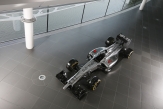
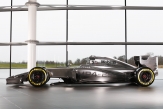
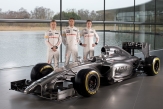
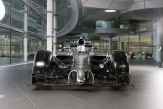
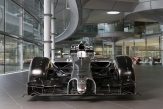
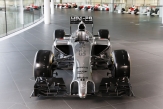
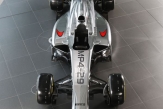
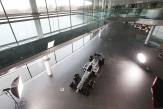

Коментари